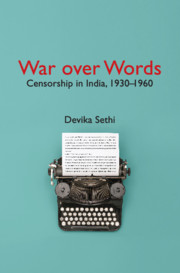Book contents
- Frontmatter
- Dedication
- Contents
- Acknowledgements
- List of Abbreviations
- Introduction
- Part I Guarding the State, Protecting the Public: Censorship Policies and Practices in the 1930s
- 1 The Power of Print
- 2 Provincial Autonomy (1937–1939) and Free Speech Controversies
- Part II Protests and Publicity: Banning Non-Indian Authors
- Part III Political or Military? Censorship in India during the Second World War
- Part IV The Censored Turn Censors: Freedom and Free Speech
- Conclusion
- Epilogue
- Bibliography
- Name Index
- General Index
1 - The Power of Print
from Part I - Guarding the State, Protecting the Public: Censorship Policies and Practices in the 1930s
Published online by Cambridge University Press: 26 April 2019
- Frontmatter
- Dedication
- Contents
- Acknowledgements
- List of Abbreviations
- Introduction
- Part I Guarding the State, Protecting the Public: Censorship Policies and Practices in the 1930s
- 1 The Power of Print
- 2 Provincial Autonomy (1937–1939) and Free Speech Controversies
- Part II Protests and Publicity: Banning Non-Indian Authors
- Part III Political or Military? Censorship in India during the Second World War
- Part IV The Censored Turn Censors: Freedom and Free Speech
- Conclusion
- Epilogue
- Bibliography
- Name Index
- General Index
Summary
Debates about freedom of expression and censorship in official files and in the legislative realm had very tangible—and traceable—consequences on the lives of people both ordinary and extraordinary. This chapter recovers and narrates the experiences of Indians from various walks of life: school and college students, journalists and revolutionaries, politicians (and their families) and Indian Civil Service (ICS) officers, future prime ministers and at least one future president of the Indian republic. Indians who grew up in colonial India and continued their lives and careers in independent India have written or spoken about the role played by print in shaping their life choices. For many participants in and observers of India's anti-colonial movement, reading banned or controversial literature was a rite of passage. Some have recalled the thrill of reading a banned book; others have recounted the lengths to which they had to go to procure their choice of newspaper. There are accounts aplenty of the means used to send banned literature to India, and also of the experience of reading—and writing—in jail. Their testimonies, in print and in interviews recorded decades after the events in question, convey a flavour of lived experience that our other official sources—crucial as they are—lack. How did Indians consume ideas in print, and how did they resist state censorship? These are the questions this chapter seeks to answer.
Although words do inspire action, measuring their impact is not an exact science. Censorship is guesswork: its basis is speculation as to what words will inspire whom and to what effect. To the official mind in India, the causal connection between words inciting violence against the state, or other communities or classes, and the actual incidence of such violence was clear. According to the GOI, 19 crimes of a ‘terrorist nature’ were committed in India in 1929; in 1930 these nearly quadrupled to 74. In 1930 alone, 15 government employees were killed and 31 injured in bomb blasts and armed attacks. Additionally, 9 ‘innocent victims’ were killed and 62 injured in these attacks. An official statement of terrorist crime in 1929 and 1930 included a list of seven ‘confessing accused’ (two of whom were named) who stated that they had ‘imbibed revolutionary ideas from the reading of newspapers’.
- Type
- Chapter
- Information
- War over Words , pp. 25 - 39Publisher: Cambridge University PressPrint publication year: 2019

